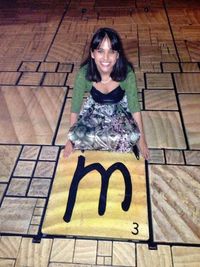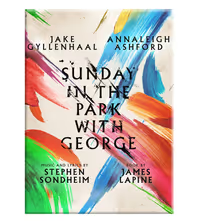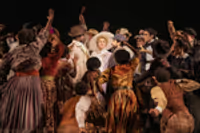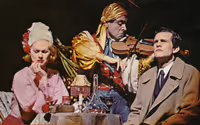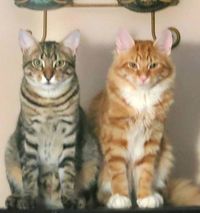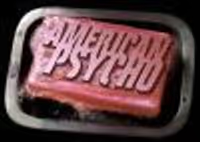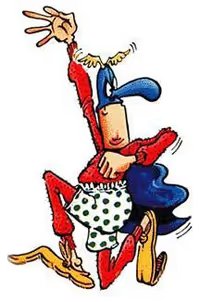NATASHA, PIERRE & THE GREAT COMET OF 1812 Previews
#300NATASHA, PIERRE & THE GREAT COMET OF 1812 Previews
Posted: 11/4/16 at 10:53am
I guess my point is that most of the recitative the show is mostly reduced to more modern 'conversational' patter. Cuckold seems a 10 point word in a show that reduces the dialogue to "Helene is a slut" "Anatole is hot" etc. At any rate, that one sung lyric flies by quickly and if you miss that one word it you don't really know what that duel is about.
#301NATASHA, PIERRE & THE GREAT COMET OF 1812 Previews
Posted: 11/4/16 at 10:58am
I had no trouble discerning this particular motivation when I saw the show in the Kazino tent. Seemed pretty clear to me, based on the text and the way the characters involved interacted.
#302NATASHA, PIERRE & THE GREAT COMET OF 1812 Previews
Posted: 11/4/16 at 10:58am
"Cuckold" is having a weird resurgence as an insult in the alt-right community and it's slipping back into the mainstream.
I agree though that until recently it wasn't a word you heard used much outside of period pieces.
#303NATASHA, PIERRE & THE GREAT COMET OF 1812 Previews
Posted: 11/4/16 at 11:10am
The first time I saw the show I thought it was pretty obvious why the duel happened. Those two were all over each other at the club and then Pierre shouts "How dare you touch her?!" or something like that.
I saw the show again last night and Natasha Lost was still cut. Also, the strobe lights seemed to be dulled down some. Though, this time I was in the last row of the Mezz so maybe the strobes are less intense from there. At intermission I was moved to center orchestra because the man next to me in the Mezz was drunk and passing out while spilling his drink on me. The view from Orchestra was great with all the action and actors. However, the lighting and set design are truly breathtaking from the mezzanine. Plus seeing the ensemble up there during Dust and Ashes was very powerful.
#304NATASHA, PIERRE & THE GREAT COMET OF 1812 Previews
Posted: 11/4/16 at 3:37pm
Super short notice but my plans went south today, so if anyone wants to buy a stage seat for tonight's show, PM me.
#305NATASHA, PIERRE & THE GREAT COMET OF 1812 Previews
Posted: 11/6/16 at 1:17am
Hey I'm looking at some rear mezzanine seats. How's the view from up there?
#306NATASHA, PIERRE & THE GREAT COMET OF 1812 Previews
Posted: 11/6/16 at 3:28am
The people that have commented spoke positively of that
#307NATASHA, PIERRE & THE GREAT COMET OF 1812 Previews
Posted: 11/6/16 at 5:16am
icecreambenjamin said: "Hey I'm looking at some rear mezzanine seats. How's the view from up there?"
I was in the rear mezz, and the view was terrific.
#308NATASHA, PIERRE & THE GREAT COMET OF 1812 Previews
Posted: 11/6/16 at 6:04am
Wow popped in here to ask how rear Mezz view was and look at what was being discussed!
Glad to hear its good, thank you all!
willep
Broadway Legend Joined: 9/20/08
#309NATASHA, PIERRE & THE GREAT COMET OF 1812 Previews
Posted: 11/6/16 at 8:14am
Having already seen it from s better seat, I felt a bit disconnected in the rear mezzanine, but it's still a good view and you can really appreciate the whole production.
#310NATASHA, PIERRE & THE GREAT COMET OF 1812 Previews
Posted: 11/6/16 at 8:55am
When I see it again, I will surely need to see if from the rear mezz, because that's generally all I can afford. From what most people who've sat there are saying here, it sounds like the view is quite interesting. But I was so blessed yesterday. Out-of-town friends were unable to use their premium orchestra seats (more than I have ever paid for a ticket) and a NY friend and I were able to see it from the center aisle seats in row F. So much happened so close to us. It was amazing. With the stage staircases to the mezzanine, I was curious what the experience was like there. Hope to find out soon. I guess I should get tickets again right away -- thinking they'll be in very short supply after opening night and what I expect will be (mostly) rave reviews.
#311NATASHA, PIERRE & THE GREAT COMET OF 1812 Previews
Posted: 11/6/16 at 8:38pm
Saw it today and have mixed feelings. First of all, this may be the first show I've seen in which the orchestra is the worst section to sit in. I spent most of the show feeling vaguely resentful that I wasn't onstage or even in the mezzanine.
As for the show, I agree with a lot of the detractors. The story is wafer thin and I couldn't really connect with the characters. Natasha is a naive, idiotic child and I kept waiting to see how they could possibly make her into a sympathetic protagonist, but they never did. Pierre is a more interesting character but a bit underdeveloped, and none of the other characters made much of an impression
That said, I enjoyed myself, and was never bored. I thought Groban was fantastic, and "Dust and Ashes" was the high point for me. Benton is gorgeous and has a lovely voice. The staging is fun (comparisons to Moulin Rouge are apt) and the visuals are sumptuous. The sound was perfect -- I had no trouble hearing anything. The many entreaties to keep our programs open to the plot summary and family tree were unfounded, as it was very easy to follow.
All in all, I had a good time, but left feeling underwhelmed and unsatisfied, and in retrospect it seems riddled with flaws.
#312NATASHA, PIERRE & THE GREAT COMET OF 1812 Previews
Posted: 11/6/16 at 11:55pm
Random question, but I'm seeing it in a few weeks and sitting onstage in the banquettes, does everyone onstage get a pierogi/vodka or just people at tables?
Because that pierogi/borscht in the tent was A+.
#313NATASHA, PIERRE & THE GREAT COMET OF 1812 Previews
Posted: 11/7/16 at 6:21am
Nobody gets vodka.
neonlightsxo
Broadway Legend Joined: 7/29/08
#314NATASHA, PIERRE & THE GREAT COMET OF 1812 Previews
Posted: 11/7/16 at 10:00am
"Natasha is a naive, idiotic child and I kept waiting to see how they could possibly make her into a sympathetic protagonist, but they never did."
I hate to say it, but I think that's just Denee's portrayal. I saw Lauren Zakrin downtown and didn't feel that way at all, but I definitely agree that Denee plays Natasha that way.
#315NATASHA, PIERRE & THE GREAT COMET OF 1812 Previews
Posted: 11/7/16 at 10:32am
Well, I think you could make the argument that Natasha's behavior is that of a naive, idiotic child - her behavior is really no different than that of say, Juliet. I think Benton's portrayal works really only in that she does project that kind of innocence and naivety that makes her foolish choices understandable. Phillipa Soo's portrayal was a lot more complicated (and vocally impressive) but it was also less youthful.
sppunk
Leading Actor Joined: 6/18/16
#316NATASHA, PIERRE & THE GREAT COMET OF 1812 Previews
Posted: 11/7/16 at 10:58am
Saw this Saturday afternoon.
I rwly enjoyed it. The story of quite thin and I felt the character development of Pierre was significantly lacking.
I adored the music however, the design is stunning and the experience is immersive. We sat in the 2nd row of the front mezz and wouldn't trade it for another other seat except the booths on stage. If you have orchestra tickets I'm sorry but you will miss quite a lot of this performance.
#317NATASHA, PIERRE & THE GREAT COMET OF 1812 Previews
Posted: 11/7/16 at 11:08am
I've been seeing lots of Instagram posts/people mentioning some pierogi in a Chinese food take-out box thing. What's up with that? Do they sell them at the bar? Or are they free and already at your seat? Does everyone get these? Also, what's with that egg that has the show's logo on it?
Sorry for being annoying, I'm really wanting to see this show but I'm quite unfamiliar with it. Seems like a great experience.
neonlightsxo
Broadway Legend Joined: 7/29/08
#318NATASHA, PIERRE & THE GREAT COMET OF 1812 Previews
Posted: 11/7/16 at 11:12am
The pierogis are tossed out by ensemble members to some of the audience. Free. The egg is a shaker (like a percussion instrument) also handed out by the ensemble (Free) to be used during the Balaga number.
No, not everyone gets them. They hand them out until they run out. Updated On: 11/7/16 at 11:12 AM
#319NATASHA, PIERRE & THE GREAT COMET OF 1812 Previews
Posted: 11/7/16 at 1:16pm
loveinnewyorkcity said: "I've been seeing lots of Instagram posts/people mentioning some pierogi in a Chinese food take-out box thing. What's up with that? "
My cast member explicitly called mine a dumpling, and as someone who grew up with pierogies, this is certainly not a pierogi. Off-Broadway, it was a proper pierogi...
neonlightsxo
Broadway Legend Joined: 7/29/08
HSky
Leading Actor Joined: 8/9/14
#321NATASHA, PIERRE & THE GREAT COMET OF 1812 Previews
Posted: 11/7/16 at 1:38pm
Here's an article about the piroshki - http://www.wsj.com/articles/war-and-peace-and-pierogies-and-piroshkis-1472605159
#322NATASHA, PIERRE & THE GREAT COMET OF 1812 Previews
Posted: 11/7/16 at 2:37pm
I was actually really interested in the article...but I'm not a subscriber. ![]()
#323NATASHA, PIERRE & THE GREAT COMET OF 1812 Previews
Posted: 11/7/16 at 3:18pm
Looks like the lottery e-mail finally realized telling people about long-gone rush tickets for tonight's performance was a bad idea:
"Other tickets ranging from $59 to 169 may be available for The Great Comet. Please visit Telecharge.com or the Imperial Theatre box office at 249 West 45th Street for best availability."
#324NATASHA, PIERRE & THE GREAT COMET OF 1812 Previews
Posted: 11/7/16 at 3:28pm
HSky said: "Here's an article about the piroshki - http://www.wsj.com/articles/war-and-peace-and-pierogies-and-piroshkis-1472605159"
Opening the musical “Natasha, Pierre & the Great Comet of 1812” on Broadway this fall involves several challenges for its creative team. Among them are: bringing in banquettes and dining tables to the Imperial Theatre; restaging an intimate musical in a much larger house; and incorporating singer Josh Groban into the company.
But there is also the issue of pierogies.
The show, loosely based on Tolstoy’s “War and Peace,” originated when creator Dave Malloy was visiting Moscow on a sound designer grant. Though he was writing a different show at the time, he found himself at a place called Café Margarita, a pub that had a string orchestra of musicians spread out around the room, dumplings and vodka on every table, and shakers with which to play music, too.
“It was just the most perfect night,” he said. “Comet” was only a glimmer in his eye then, “but I knew this is how it should be done,” Mr. Malloy explained, “where the audience is part of the evening.”
When the show opened at Ars Nova in 2012, the space was transformed into a kind of modern Russian supper club, complete with free-flowing vodka and pierogies. The show proved popular enough that it transferred to a tent in the Meatpacking District in May 2013, then to another in Midtown later that year, before being remounted, in 2015, in a proscenium theater at the American Repertory Theater in Cambridge, Mass.
It is that production, with Mr. Groban added, that will be performed on Broadway.
“Every time we’ve moved the show, there have been pierogies,” saidRachel Chavkin, the director. Food was given to welcome guests to the experience, as “an opening gesture,” she said. “It’s literally a breaking bread.”
“It’s hearty, comfort food and it makes you feel at home,” said Mr. Malloy.
The pierogies at Ars Nova came frozen, from Costco, Ms. Chavkin recalled.
“And I love a Costco pierogi,” she added.
“They were fine,” said Mr. Malloy, “but nothing like the thing I had at Café Margarita in Moscow.”
Guests at the tented productions sat at tables and were served even more food than just pierogies, which sometimes came with onions.
“They were wet,” Ms. Chavkin said, “but at the tent there were lots of napkins.”
At ART, the pierogies came from a local restaurant.
“They were good, and they were filling,” said Mr. Malloy.
“But they were also a little slimy,” said Ms. Chavkin. “There was an oil that was delicious that made for a messy experience.”
But there were also questions that arose at ART. Among them, did everyone, in fact, need a pierogi for the act of serving them to be successful? Did everyone even want a pierogi?
“We worked very hard so that everyone had access to a dumpling,” said Ms. Chavkin. But the last people receiving them were often getting their pierogies lukewarm or even cold.
Which brings us to the issue at hand: how to feed the thousand-plus audience members on West 45th Street at the Imperial? The job of solving the pierogi conundrum has fallen to Howard Kagan, a lead producer of the show.
The other day, Ms. Chavkin and Messrs. Malloy and Kagan gathered at the Russian Samovar on West 52nd Street to discuss the issue and have a casual taste test of some options.
The first kind that was brought out was a pastry of sorts, with spinach. The consensus was they tasted good, but “ladies hate when spinach gets in their teeth,” said Mr. Kagan, so they were factored out. A meat option was also denied because a lot of people are vegetarians. The thought was a knife and fork should not be necessary.
But Mr. Kagan had planned ahead. He had asked the kitchen to prepare a potato pastry called “piroshki,” which Mr. Malloy and Ms. Chavkin proceeded to eat with relish.
“They’re beautiful,” said Ms. Chavkin as she looked at the plate.
“It’s like a Russian Hot Pocket,” said Mr. Malloy, as he took another one.
Mr. Kagan said he wanted the piroshkis to be a little smaller, but the plan was for the Samovar to deliver an order for each performance—about one per three audience members. The pastries would come to the prop crew in warming envelopes or miniature boxes not long before showtime. They would then be given to the actors, who would then burst through the show’s red curtains to start the show and ask: “Who wants a piroshki?”
The individualized boxes were important, he said, “because they can be eaten then or they can be eaten later if they want to.”
And this way, Mr. Kagan explained, “the room will not be filled with the smell of pierogies.”
Videos





